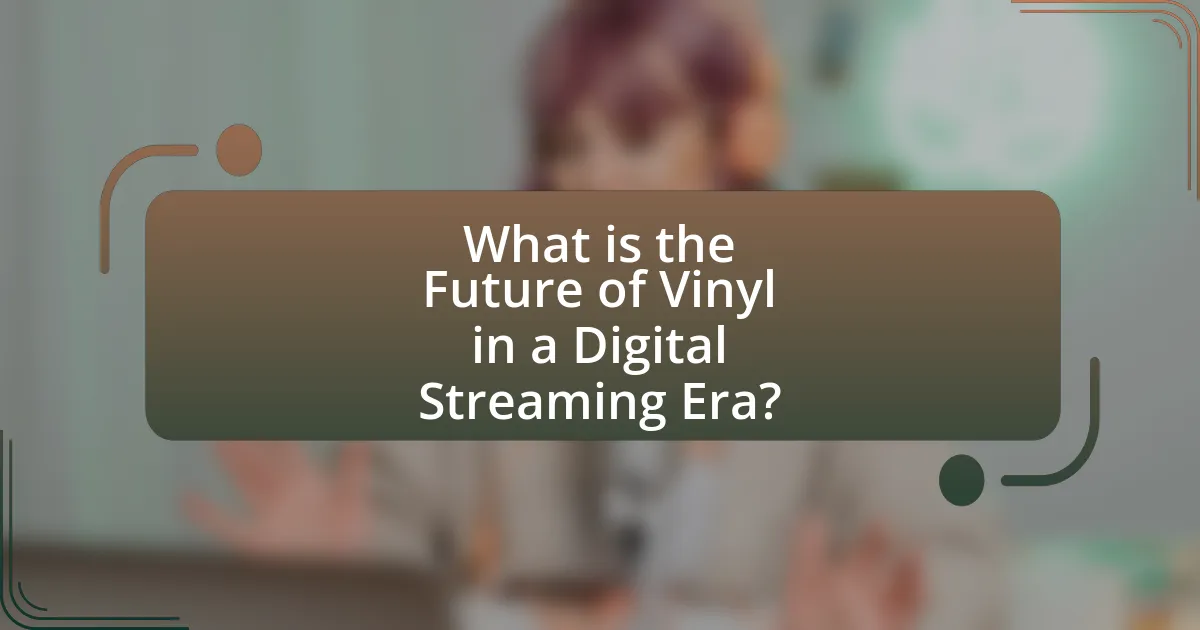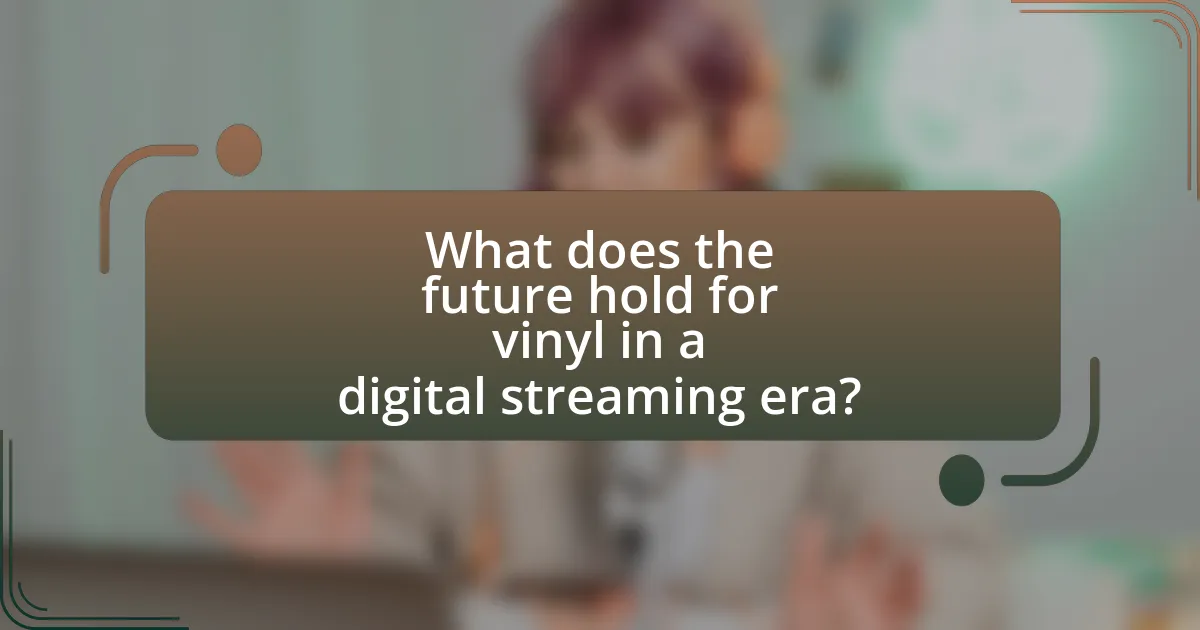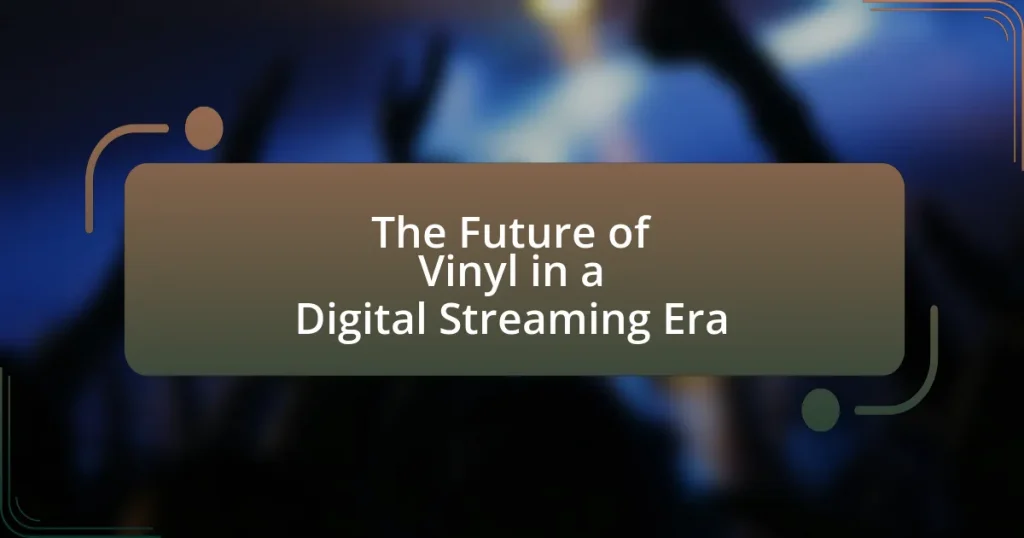The article examines the future of vinyl records in the context of a digital streaming era, highlighting a significant resurgence in vinyl sales, which accounted for 41% of all physical music sales in the United States in 2022. It explores the factors contributing to this trend, including consumer nostalgia, the tactile experience of vinyl, and the unique sound quality that appeals to audiophiles. The article also discusses the challenges faced by the vinyl industry, such as competition from digital formats and production issues, while emphasizing the role of limited editions and artist collaborations in driving consumer interest. Additionally, it addresses emerging demographic trends among vinyl buyers and the impact of digital platforms on marketing and distribution strategies.

What is the Future of Vinyl in a Digital Streaming Era?
The future of vinyl in a digital streaming era appears promising, as vinyl sales have consistently increased despite the prevalence of digital music. In 2022, vinyl records accounted for 41% of all physical music sales in the United States, marking the highest percentage since the 1990s, according to the Recording Industry Association of America (RIAA). This resurgence is driven by a growing appreciation for the tactile experience and sound quality of vinyl, as well as the collectible nature of records. Additionally, many artists and labels are releasing exclusive vinyl editions, further fueling consumer interest. The combination of nostalgia and a desire for physical media suggests that vinyl will continue to thrive alongside digital streaming platforms.
How has the vinyl industry evolved in the age of digital streaming?
The vinyl industry has experienced a significant resurgence in the age of digital streaming, with sales reaching their highest levels since the 1980s. In 2022, vinyl records accounted for 50% of all physical music sales in the United States, surpassing CD sales for the first time since 1987, according to the Recording Industry Association of America (RIAA). This evolution is driven by a growing consumer preference for tangible music formats, nostalgia, and the unique sound quality that vinyl offers, which contrasts with the convenience of digital streaming. Additionally, artists and labels have capitalized on this trend by releasing exclusive vinyl editions and special pressings, further fueling demand.
What historical factors contributed to the resurgence of vinyl?
The resurgence of vinyl can be attributed to a combination of nostalgia, the desire for tangible music formats, and the unique sound quality associated with vinyl records. Nostalgia plays a significant role, as many consumers who grew up with vinyl in the 1970s and 1980s are now seeking to reconnect with their past. Additionally, the tactile experience of handling records and the large-format album art appeals to collectors and music enthusiasts. The sound quality of vinyl, often described as warmer and richer compared to digital formats, has also attracted audiophiles who appreciate the analog experience. According to the Recording Industry Association of America (RIAA), vinyl sales have seen consistent growth, with revenue from vinyl records surpassing that of CD sales in 2020, highlighting the format’s renewed popularity and cultural significance.
How do sales trends compare between vinyl and digital formats?
Sales trends indicate that vinyl sales have been experiencing a resurgence, while digital format sales have plateaued or declined. In 2022, vinyl records accounted for 41% of all physical music sales in the United States, marking the first time since the 1980s that vinyl outsold CDs. In contrast, digital downloads have seen a significant decrease, with a reported drop of 20% in 2021, as consumers increasingly shift towards streaming services. This trend highlights a growing preference for the tactile and nostalgic experience of vinyl, juxtaposed against the convenience of digital formats, which are now primarily dominated by streaming platforms.
Why is vinyl still relevant despite the dominance of digital streaming?
Vinyl remains relevant due to its unique sound quality and tangible experience that digital streaming cannot replicate. The analog format of vinyl records provides a warmth and depth in audio that many audiophiles prefer, as evidenced by a 2020 report from the Recording Industry Association of America (RIAA) which noted that vinyl sales reached their highest level since the 1980s, surpassing CD sales for the first time in over three decades. Additionally, the physical nature of vinyl records fosters a deeper connection between the listener and the music, as collectors value the artwork and the ritual of playing a record. This combination of superior sound quality and a nostalgic, immersive experience contributes to vinyl’s enduring appeal in an increasingly digital world.
What unique qualities does vinyl offer that digital formats do not?
Vinyl offers a unique auditory experience characterized by warmth and depth that digital formats often lack. The analog nature of vinyl records allows for a richer sound profile, capturing nuances in music that digital compression can diminish. Additionally, the physicality of vinyl creates a tactile engagement with music, as listeners interact with the medium through handling records and using turntables. This engagement fosters a more immersive listening experience, which is supported by studies indicating that many audiophiles prefer the sound quality of vinyl over digital formats due to its analog characteristics.
How does the tactile experience of vinyl influence consumer preferences?
The tactile experience of vinyl significantly influences consumer preferences by enhancing the emotional connection and perceived value of music. This sensory engagement, characterized by the physical act of handling records, contributes to a more immersive listening experience, which many consumers find appealing compared to digital formats. Research indicates that 70% of vinyl buyers cite the tangible nature of records as a primary reason for their purchase, highlighting the importance of physical interaction in consumer decision-making. Additionally, the larger album artwork and the ritual of playing a record create a unique experience that resonates with consumers seeking authenticity and nostalgia in an increasingly digital world.
What challenges does the vinyl industry face in a digital world?
The vinyl industry faces significant challenges in a digital world, primarily due to the dominance of streaming services that offer instant access to music. This shift has led to a decline in physical sales, as consumers increasingly prefer the convenience of digital formats over purchasing vinyl records. According to the Recording Industry Association of America (RIAA), while vinyl sales have seen a resurgence, they still represent a small fraction of overall music revenue, with streaming accounting for over 80% of the market. Additionally, the production of vinyl records is often hampered by supply chain issues and rising manufacturing costs, which can limit availability and increase prices. These factors create a complex landscape for the vinyl industry as it attempts to maintain relevance amidst the growing preference for digital consumption.
How do production and distribution issues affect vinyl availability?
Production and distribution issues significantly limit vinyl availability by creating bottlenecks in manufacturing and logistics. The resurgence in vinyl popularity has led to increased demand, but many pressing plants operate at capacity, resulting in longer lead times for production. For instance, in 2021, the average wait time for vinyl records reached up to six months due to these constraints. Additionally, distribution challenges, such as shipping delays and increased freight costs, further exacerbate the situation, making it difficult for retailers to maintain stock. This combination of production and distribution hurdles directly impacts the accessibility of vinyl records for consumers.
What impact does digital piracy have on vinyl sales?
Digital piracy negatively impacts vinyl sales by reducing the perceived value of music and encouraging consumers to opt for free digital downloads instead of purchasing physical formats. A study by the International Federation of the Phonographic Industry (IFPI) found that 30% of music consumers engage in piracy, which can lead to decreased revenue for artists and labels. This decline in revenue affects the production and distribution of vinyl records, as fewer sales can result in limited pressings and availability. Consequently, while vinyl has seen a resurgence in popularity, the presence of digital piracy poses a significant challenge to its market sustainability.

How is the vinyl market adapting to digital trends?
The vinyl market is adapting to digital trends by integrating technology into the vinyl experience, enhancing accessibility and engagement. For instance, many vinyl records now include digital download codes or QR codes that link to streaming platforms, allowing consumers to enjoy both physical and digital formats. According to the Recording Industry Association of America (RIAA), vinyl sales reached 41 million units in 2022, indicating a resurgence that coexists with the growth of digital music consumption. This adaptation reflects a strategic response to consumer preferences for tangible music formats while still embracing the convenience of digital access.
What strategies are vinyl manufacturers using to compete with streaming services?
Vinyl manufacturers are competing with streaming services by emphasizing the tangible and collectible nature of vinyl records. They focus on producing high-quality, limited-edition releases that appeal to audiophiles and collectors, thereby creating a unique value proposition that streaming cannot replicate. For instance, the resurgence of vinyl sales has been marked by a 29% increase in revenue in 2020, according to the Recording Industry Association of America, highlighting consumer interest in physical formats. Additionally, vinyl manufacturers are collaborating with artists to offer exclusive content, such as colored vinyl or special packaging, which enhances the overall experience and encourages purchases over streaming.
How are collaborations with artists influencing vinyl releases?
Collaborations with artists are significantly influencing vinyl releases by creating unique, limited-edition products that appeal to collectors and fans. These collaborations often result in exclusive artwork, special packaging, and unique color variants, which enhance the aesthetic and collectible value of vinyl records. For instance, the partnership between Billie Eilish and the vinyl manufacturer Third Man Records produced a special edition of her album “When We All Fall Asleep, Where Do We Go?” that featured a glow-in-the-dark vinyl, attracting both her fanbase and vinyl collectors. This trend not only boosts sales but also revitalizes interest in vinyl as a tangible medium in an era dominated by digital streaming.
What role does limited edition vinyl play in attracting collectors?
Limited edition vinyl plays a significant role in attracting collectors by offering unique and exclusive items that enhance the value and desirability of a collection. The scarcity of limited editions, often produced in small quantities, creates a sense of urgency and exclusivity among collectors, driving demand. For instance, a report from the Recording Industry Association of America (RIAA) indicates that vinyl sales have surged, with limited editions often commanding higher prices in the resale market, reflecting their appeal to collectors seeking rare items. This phenomenon is further supported by the fact that collectors often prioritize unique artwork, colored vinyl, and special packaging, which are common features of limited edition releases, making them more attractive than standard pressings.
How are consumer behaviors changing in relation to vinyl and digital music?
Consumer behaviors are shifting towards a renewed interest in vinyl music while maintaining a strong preference for digital formats. This change is evidenced by a significant increase in vinyl sales, which reached 41 million units in 2020, marking the highest sales figures since the 1980s, according to the Recording Industry Association of America. Concurrently, digital music consumption continues to dominate, with streaming services accounting for over 80% of music revenue in the same year. This dual trend indicates that while consumers appreciate the tactile and nostalgic qualities of vinyl, they also rely on the convenience and accessibility of digital music platforms.
What demographic trends are emerging among vinyl buyers?
Emerging demographic trends among vinyl buyers indicate a significant increase in younger consumers, particularly millennials and Gen Z, who are driving the resurgence of vinyl records. According to a 2022 report by the Recording Industry Association of America, vinyl sales reached their highest level since the 1980s, with 50% of buyers aged 18 to 34. This demographic shift highlights a growing appreciation for physical music formats and nostalgia, as younger generations seek tangible connections to music in an era dominated by digital streaming. Additionally, there is a notable rise in female vinyl buyers, with women now accounting for approximately 40% of vinyl sales, reflecting a broader diversification of the vinyl market.
How do social media and online communities impact vinyl culture?
Social media and online communities significantly enhance vinyl culture by facilitating connections among enthusiasts and providing platforms for sharing information and experiences. These digital spaces enable collectors to discuss rare finds, share album artwork, and promote local record shops, thereby fostering a sense of community. For instance, platforms like Instagram and Facebook host groups where users can showcase their collections and engage in discussions, which has led to a resurgence in vinyl sales; according to the Recording Industry Association of America, vinyl sales reached 41 million units in 2020, the highest level since 1986. This interaction not only cultivates a vibrant culture around vinyl but also drives new listeners to explore the format, blending traditional music appreciation with modern digital engagement.

What does the future hold for vinyl in a digital streaming era?
The future of vinyl in a digital streaming era appears promising, as vinyl sales have been experiencing a resurgence. In 2022, vinyl records outsold CDs in the United States for the first time since the 1980s, with vinyl sales reaching 41 million units compared to 33 million CDs, according to the Recording Industry Association of America (RIAA). This trend indicates a growing consumer preference for the tactile and nostalgic experience that vinyl offers, despite the convenience of digital streaming. Additionally, the unique sound quality and collectible nature of vinyl records continue to attract audiophiles and collectors, ensuring that vinyl maintains a significant presence in the music industry alongside digital formats.
How might technological advancements influence vinyl production?
Technological advancements may significantly enhance vinyl production by improving manufacturing efficiency and sound quality. Innovations such as digital cutting technology allow for more precise groove placement, resulting in better audio fidelity. Additionally, advancements in materials, like high-quality PVC and new formulations for vinyl, can lead to records that are more durable and less prone to warping. For instance, the introduction of 3D printing techniques in vinyl production can enable custom designs and faster prototyping, streamlining the overall production process. These developments not only cater to the growing demand for vinyl records but also ensure that the medium remains competitive in a digital streaming era.
What innovations are being explored to enhance the vinyl listening experience?
Innovations being explored to enhance the vinyl listening experience include advancements in turntable technology, improved cartridge design, and the integration of digital features. High-fidelity turntables now utilize precision engineering and materials that reduce vibration and enhance sound quality, such as carbon fiber and aluminum. Additionally, modern cartridges are designed with advanced stylus shapes that optimize contact with the vinyl grooves, resulting in clearer sound reproduction. Some manufacturers are also incorporating Bluetooth connectivity and built-in digital converters, allowing users to digitize their vinyl collections while maintaining analog warmth. These innovations are supported by a resurgence in vinyl sales, which reached 41 million units in 2022, indicating a strong consumer interest in high-quality audio experiences.
How could sustainability practices shape the future of vinyl manufacturing?
Sustainability practices could significantly shape the future of vinyl manufacturing by reducing environmental impact and promoting resource efficiency. Implementing eco-friendly materials, such as bio-based plastics and recycled vinyl, can minimize waste and lower carbon emissions during production. For instance, companies like Vinyl Me, Please have started using recycled materials, which not only conserves resources but also appeals to environmentally conscious consumers. Additionally, adopting renewable energy sources in manufacturing processes can further decrease the carbon footprint associated with vinyl production. According to a 2021 report by the International Energy Agency, transitioning to renewable energy could reduce greenhouse gas emissions in the manufacturing sector by up to 70%. Therefore, integrating sustainability practices into vinyl manufacturing not only addresses environmental concerns but also aligns with consumer demand for greener products.
What are the potential growth areas for vinyl in the coming years?
The potential growth areas for vinyl in the coming years include increased demand in the music industry, expansion into new markets, and the rise of vinyl as a collectible item. The resurgence of interest in analog formats, driven by younger consumers seeking tangible music experiences, has led to a significant increase in vinyl sales, which reached 41 million units in the U.S. in 2022, the highest level since 1987. Additionally, vinyl’s appeal as a premium product for audiophiles and collectors is expected to drive growth, with limited edition releases and collaborations becoming more common. Furthermore, the global market for vinyl records is projected to grow at a compound annual growth rate (CAGR) of 12.8% from 2023 to 2030, indicating strong future potential.
How can vinyl labels leverage digital platforms for marketing?
Vinyl labels can leverage digital platforms for marketing by utilizing social media, streaming services, and e-commerce websites to reach a broader audience. Social media platforms like Instagram and TikTok allow vinyl labels to showcase their products visually and engage with fans through targeted advertising and influencer partnerships. Streaming services, such as Spotify and Apple Music, can be used to promote new releases and drive traffic to vinyl sales by offering exclusive content or pre-order options. E-commerce websites enable direct sales to consumers, enhancing accessibility and convenience. According to a report by the Recording Industry Association of America (RIAA), vinyl sales reached a record high of $1 billion in 2020, indicating a growing market that digital platforms can effectively tap into for promotional strategies.
What new markets are emerging for vinyl records globally?
Emerging markets for vinyl records globally include countries such as China, India, and Brazil. In China, the vinyl market has seen significant growth, with sales increasing by over 50% annually since 2018, driven by a rising middle class and a growing interest in music culture. India is experiencing a resurgence in vinyl popularity, with local artists and labels producing records, reflecting a blend of traditional and contemporary music styles. Brazil’s vinyl market is also expanding, supported by a vibrant music scene and a nostalgic appreciation for analog formats. These markets are contributing to the overall global resurgence of vinyl, which has seen sales surpass 40 million units in 2022, according to the Recording Industry Association of America.
What practical tips can vinyl enthusiasts follow to thrive in a digital era?
Vinyl enthusiasts can thrive in a digital era by integrating digital tools with their vinyl collections. Utilizing streaming services to discover new music can complement vinyl collections, allowing enthusiasts to stay updated with current trends while enjoying the tactile experience of vinyl. Additionally, engaging with online communities and social media platforms dedicated to vinyl can enhance their knowledge and appreciation of the medium. According to a report by the Recording Industry Association of America, vinyl sales have increased significantly, indicating a resurgence in interest that can be leveraged through digital marketing and online sales platforms. By combining traditional vinyl collecting with modern digital resources, enthusiasts can maintain relevance and expand their enjoyment of music.
